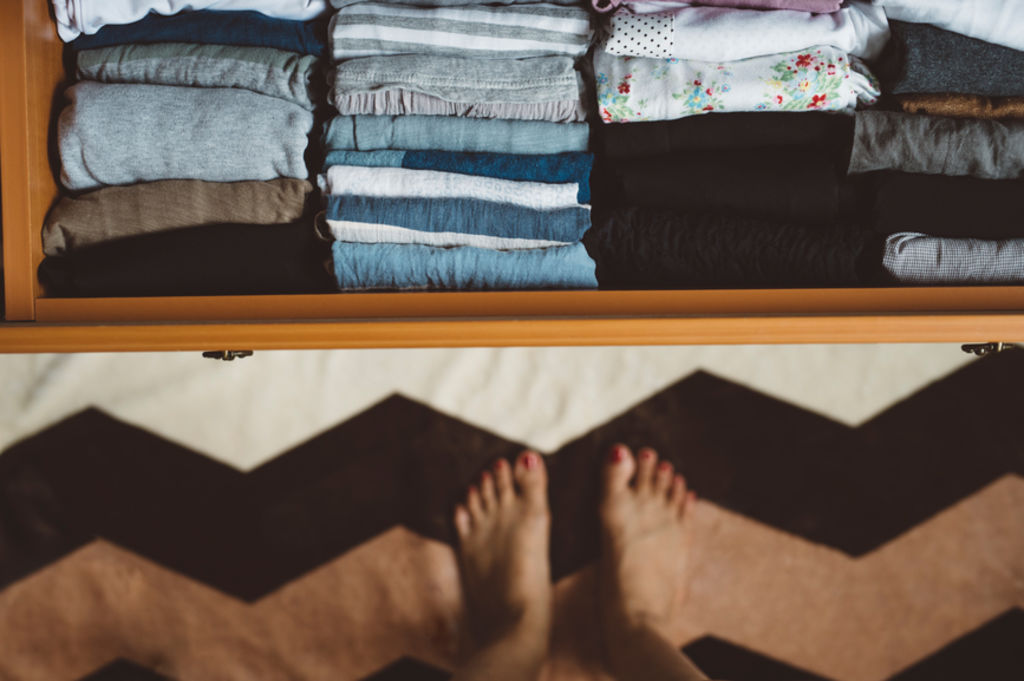Eight small changes to make your life more organised

Author: Laura Gaskill, Houzz Contributor
Imagine walking into someone’s home, opening the junk drawer and seeing not a pile of junk, but neat little compartments holding necessary items. A pantry where the jars and cans are lined up like soldiers, shelves labelled and not even close to overflowing; a sock drawer where every sock has a mate.
For a home to be kept thoroughly organised, you have to be mindful of the smallest habits, the tiniest motions and details – otherwise things rapidly descend into chaos. But is all that mindfulness possible for a mere mortal? I am beginning to think that what separates the truly organised from the rest of us is how the little things are handled. What if, by starting with a commitment to keep one small area of your house ultra-tidy, you were able to create a domino effect that eventually affects every room?
Here we’ll take a look at eight small areas that can be problems and reveal ways to transform them into beacons of an organised life.

1. The bedside table
I admit it; I have been known to carry huge stacks of books, magazines and notebooks – more than any human could possibly read in a week, let alone in one sitting – to bed with me.
The teetering mass flows over the bedside table on to the floor, tumbles under the bed and inevitably spreads on to the adjacent radiator cover. And really, that’s fine … for a short time. But if you have a similar problem, and the mess stays (or grows) all week long, it may be time for an intervention.
I plan to start by adding a small vase of fresh flowers, a candle and a small piece of art beside the bed. Having something lovely to wake up to seems like a positive motivation to take that extra minute in the evening, before shutting off the light, to put the books, tablet or magazines away. This seems like such an easy fix, I may start with this as my first new habit.
2. The entry
The main problem here tends to be the habit of leaving lots of things out because you may want them at some point during the week.
To transform this area, start thinking about only the next day. Will you wear those boots again tomorrow? What about the jacket, scarf and bag? If not, put them away in a main cupboard or wardrobe instead of letting them pile up by the front door.
Set out just what you need, and not only will your entry look neater, you’ll also get out the door more quickly and easily in the morning.

3. The utensil drawer
We all have that one main kitchen drawer that houses utensils – no problem there. But it isn’t just utensils, is it? It also likely holds a random assortment of cooking tools, cookie cutters, various thermometers, broken chopsticks and a few stray rubber bands … at least mine does.
The problem here, I think, is that the utensils don’t quite fill the drawer completely, which leaves ample room for marauders like leftover skewers from the barbecue last summer. I suggest we start thinking of this drawer as the kitchen workhorse drawer: let it contain your everyday cutlery, plus any other small tools you reach for constantly (measuring cups and spoons, an extra timer), and that’s it.
How to arrange your kitchen cupboards

4. The pantry
Containers are a problem in the pantry – they look messy, and the jumble of sizes and shapes makes it hard to find things.
Decanting the things you buy constantly into airtight containers is definitely something a highly organised person would do. Don’t, however, fall into the slightly less organised person’s trap of buying all of those special containers, decanting everything into them one time and then continuing to buy regular packages and shoving them in on top of the pretty ones, which then tumble over, completely ignored and neglected.
I suggest starting instead by making it a routine to go through the pantry every time you go to the market. Consolidate containers, clear out old stuff and wipe down the shelves. Add a few nice wire baskets if you want to corral wayward boxed goods.
And if you do want to upgrade to pretty matching containers, remember to label their contents.
Find out more on how to organise your pantry

5. The junk drawer
Let’s begin by not calling this the junk drawer – call it the “really useful stuff” drawer instead. Batteries, scissors, stamps … this is stuff you need! No actual junk belongs in there. If there is any junk, get it out. If it’s still crammed too full, you probably have some not-so-useful stuff in there, like old birthday cards and that dead cell phone you’ve been meaning to recycle. Get that out, too. Now add neat little dividers and give yourself a great big pat on the back.

6. The bathroom sink
Clutter problems in this area tend to come from a combination of a) being short on time in the mornings, and b) having too many products. Also, it may be necessary to face the fact that you just do not like getting things in and out of a medicine cabinet.
Try keeping your daily essential toiletries in one or two nice-looking baskets, lidded or not, set atop the sink or toilet. Should you buy another toiletry product that doesn’t fit in your allotted bins, get rid of something else.
As for time in the mornings, if you make it a habit to put everything back in its place when you are done using it, your getting-ready area will be as neat as a pin the next morning, actually making it quicker to get out the door.
How to sort out your bathroom storage

7. The sock drawer
What is it about socks, for heaven’s sake? I’ve given up on always finding every sock’s mate, but I have committed to giving each lone sock an ultimatum: lone socks no longer live in my drawer. They are immediately booted back to the laundry room, where they will remain until another cycle of wash has gone through. If no mate has been found by that time, it goes in the bin.
This works amazingly well, and I’ve found that my family has lost very few socks since putting this system in place. To take it to the next level, you will need some sort of drawer dividers to give each pair of socks and tights their own cosy little home. I think just peeking into a drawer this organised would make me feel more positive about life in general.
8. The coffee table
The coffee table was never much of a problem in my house until we had a child. Now we rarely see the top of it. It does seem unnecessary to get too regimented about keeping surfaces perfectly cleared throughout the day, but a once- or twice-daily clearing of the decks can help keep this area neat. Having a nice tray to place on top can help give you something to aspire to – knowing your coffee table has the potential to look cute may be enough motivation to get you to keep it that way.
We recommend
We thought you might like
States
Capital Cities
Capital Cities - Rentals
Popular Areas
Allhomes
More







